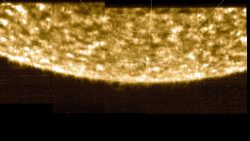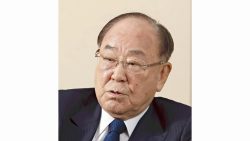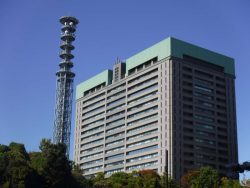Manga Classes Make Kumamoto High School Popular Across Japan; Student Debuts as Mangaka
11:00 JST, June 6, 2025
TAKAMORI, Kumamoto — The manga studies department at a Kumamoto high school is drawing attention as a successful example of the revival of public high schools, which are suffering from intensifying competition with private schools following the introduction of free tuition.
Kumamoto Prefectural Takamori High School in Takamori, Kumamoto Prefecture, became the first public high school with a manga studies department when it launched in spring 2023.
The department attracts children from across the country who dream of becoming manga artists, and one of the students who has studied in the department has already debuted as a mangaka.
Currently, about 120 first- to third-year students take manga classes at the rural mountain school, which often used to see its student numbers fall below capacity.
In February, Nobuhiko Horie, 69, president of Tokyo-based manga publisher Coamix Inc., gave a lecture to about 40 first-year students in a classroom filled with manga and art supplies.
“It would be a great success if readers of your manga think they want to return to your protagonist,” said Horie, a former editor-in-chief of the Weekly Shonen Jump manga magazine. Horie is known for being behind the birth of popular manga such as “Hokuto no Ken” (“Fist of the North Star”) and “City Hunter.”
During the class, the students discussed settings in which they could depict a “snowman who fell in love with a fireplace.” One of the students said the snowman was drawn to the warm fireplace because he himself is cold, while the other student said that the snowman found something in common with the fireplace because both its hands and the firewood are made of the same wood. With such unique opinions, Horie said: “I hope they will find and develop their own unique qualities or talents that they may not even be aware of.”
Out of 30 class hours every week in the manga department, six to 13 are dedicated to manga creation and art lessons. Coamix is responsible for two to four of these hours, and manga editors and artists teach story development and panel layout as well as providing feedback on students’ works.
One in four students in the department is from outside the prefecture, and all of them belong to the school manga club, where they make storyboards and other items after school hours, meaning they spend most of their time immersed in manga.
Osuke Araki, an 18-year-old third-year student from Oki, Fukuoka Prefecture, won an excellence award at the 11th Coamix Kyushu International Manga Award in summer last year and became the first student from the school to debut in a monthly magazine. His work “Saisen” (Rematch) depicts a man who pursues the marlin his late father failed to catch.
“There were times when I was not sure what the theme of my manga was, but I was able to complete it thanks to the advice I received at school,” Araki said. “I want to study art in college and create manga uniquely my own.”
Some of his schoolmates also won awards in the competition.
“The hard part of making manga is creating the punchline, but an environment where I can receive advice directly from experts is invaluable,“ said a second-year student from Nobeoka, Miyazaki Prefecture. A third-year student who is from Kumamoto City, said, “The happiest moments are when my friends complete their works or win awards.”
The environment of the school, in which students praise and inspire each other, is also believed to be a source of their motivation.
Revitalizing town with manga
Takamori, at the foot of Mt. Aso, is known for its tourism industry, agriculture and forestry. However, the population of the town has decreased by more than 1,000 in the past 10 years, falling below 6,000. About half of the population is elderly.
The 2016 Kumamoto Earthquake, which caused power outages and water shortages throughout the area, was another blow to the town. The high school, with a history of nearly 80 years, often saw its student numbers fall below capacity in the years afterward.
Horie, who spent his childhood in the town, became a catalyst for change. He began to collaborate with the town on regional revitalization through manga at the request of the municipal government.
When Takamori Mayor Daisei Kusamura, 58, who had worried about the future of the high school, presented Horie with the idea of establishing a manga department at the school, he readily agreed to the plan. Horie, who had been alarmed by the declining number of young people aspiring to become manga artists, said he thought the development of art, sports and other abilities that cannot be measured only by academic record should be promoted in the coming era.
The town spent about ¥400 million building a student dormitory and other facilities.
There have also been exchanges between local residents and students. While students living away from home cook local dishes together with residents, other students draw their portraits as gifts.
The prefecture has also supported the school by allocating about ¥600 million for the construction of a new school building and other purposes.
Partly thanks to such generous support measures, the school has attracted attention and entrance has become competitive, with only one in every three to four children passing the entrance exams for the manga studies department.
“The collaboration between the local government and the business has led to the revitalization of the school,” said Kengo Nagata, head of the Kumamoto prefectural board of education’s department to promote the strength of high schools.
Students at the school are also contributing to the revitalization of the town and surrounding area by doing things like creating manga based on Aso Kumamoto Airport and designing the logo for a nursery school in a neighboring village.
“I hope their experiences in Takamori will be rich enough to become a turning point in the lives of the students, and that the town will become a second or third hometown for them,” Kusamura said.
"Culture" POPULAR ARTICLE
-

World Forum on Japanese Culture Set to Kick Off; 1st Session to Feature Speech by Princess Akiko
-

‘Study Manga’ Make Easy Reading out of Educational Content, and Their Range of Themes Is Growing
-

Shosoin THE SHOW: Immersive Exhibition Brings Ancient Japanese Treasures to Life in Osaka; Treasure-inspired Modern Creations Also on Display
-

Japanese Pianists Win 2nd, 5th Prizes in Brussels Contest
-

Everyday Items Brightened with Nature’s Colors; Tokyo-Based Plant Dyeing Brand Offers Range of Products, Beginner’s Kit
JN ACCESS RANKING
-

Aichi Rice Production Under Siege from Warming Climate; Record Heat Stunts Crop Growth, Causes Greater Pest Activity
-

Japanese Researchers Develop ‘Transparent Paper’ as Alternative to Plastics; New Material Is Biodegradable, Can Be Produced with Low Carbon Emissions
-

Trump: Nippon Steel Will Part Own U.S. Steel, U.S. to Be in Control; Share Distribution, Other Details Remain Unclear
-

Japan’s Core Inflation Hits More than 2-year High, Could Force Year-End BOJ Hike
-

Japan’s Cooperation in Alaska LNG Development Project Emerges in Japan-U.S. Tariff Negotiations; But Industry Concerns Exist
























